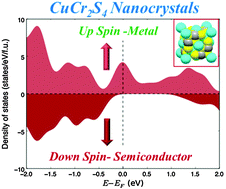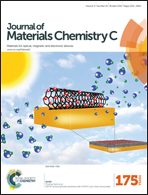Nanocrystals of CuCr2S4−xSex chalcospinels with tunable magnetic properties†
Abstract
Ferromagnetic materials exhibiting large spin polarization at room temperature have been actively pursued in recent years for the development of next-generation spintronic devices. Chromium-based chalcospinels are the only ternary chalcogenide-containing magnetic materials with Curie temperatures above room temperature. However, the magnetic and electronic properties of chromium-based chalcospinels at the nanoscale level are not well understood. We have developed a facile colloidal method for the synthesis of CuCr2S4−xSex (0 ≤ x ≤ 4) nanocrystals over the entire composition range. Systematic changes in the lattice parameter and elemental composition confirm formation of CuCr2S4−xSex (0 ≤ x ≤ 4) nanocrystals. The dimensions of the nanocrystals, as determined from TEM images, vary from 12 ± 1.4 nm to 21 ± 1.4 nm. The Curie temperature (TC) shows a systematic increase with increasing selenium content. Saturation magnetization and coercivity values of CuCr2S4−xSex (0 ≤ x ≤ 4) nanocrystals at 5 K are found to steadily increase up to x = 3. Electronic structure calculations as a function of composition and size using density functional theory suggest ferromagnetic ordering over the entire composition range with partial spin polarization for the bulk materials. Furthermore, the calculations predict complete opening-up of a gap at the Fermi level in the minority spin channel at reduced dimensions to render them completely spin polarized, i.e., display half-metallic characteristics.


 Please wait while we load your content...
Please wait while we load your content...